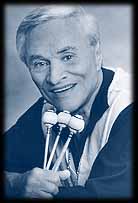
|
|
|
|
|
|
Photo Credit: Mark Mann |
Terry Gibbs
Vibraphonist and percussionist Terry Gibbs brings energy and excitement to a stage, whether he’s playing swing, bebop, or a ballad. Despite his musical talent, Gibbs once aspired to be a boxer. But through music he combines the same speed and manual dexterity with his keen sense of melody and harmony. Armed with these abilities, Gibbs has become a premiere performer, composer, and band leader. He delivers another “knock out” performance on this program, before a live audience at the Kennedy Center’s Theatre Lab. Gibbs hits the stage with a spirited rendition of Dizzy Gillespie’s “Groovin’ High”. He reminds Dr. Taylor that he’s no stranger to bebop—he was one of the earliest bebop vibists along with Milt Jackson. Billy asks Gibbs how he chose the vibraphone as his primary instrument, and together they discuss pioneers of the jazz vibraphone, including Lionel Hampton, Red Norvo, and Jackson. Growing up, Gibbs demonstrated musical ability by the age of two, and began studying the xylophone by age seven. He played with his father’s group at weddings and bar mitzvahs, and even won the Major Boles Amateur Hour on the radio at age twelve. But because he preferred jazz to classical, he turned down a scholarship to Julliard to study as a timpanist. He continued playing drums while in the army, but was more enthusiastic about competing as a boxer, fighting in twenty-two matches. Gibbs says the bebop scene rejuvenated his interest in playing jazz professionally, as he extols the founders of bebop, Dizzie Gillespie and Charlie Parker. Bebop had sprung up in New York while Gibbs was away with the army. Once, he came home on furlough and a friend took him to 52nd Street to hear this revolutionary new sound. It was love from the start for Gibbs, who spent the whole two-week leave at the clubs. He recalls his reaction to the rapid rhythms and harmonies of this breakthrough in jazz, “I didn’t believe what I heard…I was knocked out with the double time figures they played.” Before bebop, Gibbs was into swing. While growing up in New York, he recalls going to the Paramount Theater to hear Benny Goodman play. He says, “I never thought in my born days I’d ever play with him.” But like a dream come true, Goodman hired Gibbs into his band for a two and a half year stint in the early 1950’s. Gibbs recalls, “musically [it] was one of the greatest thrills of my life”, though he did feel that Goodman was somewhat aloof as a person. Billy also asks Gibbs about some of the other bands he has played with, including those of Woody Herman and Tommy Dorsey. In fact, Gibbs says he quit Tommy Dorsey’s band after one day because he felt Dorsey was ignoring the bebop influences that Gibbs found so revolutionary. More recently, Gibbs says he has been more at home as a leader of his own bands, and co-leader of groups with his close friend, clarinetist Buddy DeFranco. As Billy notes, Gibbs is a prolific composer, with hundreds of songs published. Among his milestones are tunes written for Nat King Cole and George Shearing. At Billy’s request, he does a beautiful rendition of a tune he wrote for his wife, called “Rebekah”. In response to a question from the audience, Gibbs discusses the process of composing a song. He and Billy elaborate with a discussion about jazz improvisation as a form of composing. When asked whether vibes players are “frustrated drummers or vice versa”, Gibbs says that a piano player is likely to have an advantage over a drummer in learning to play the vibes. He notes the similarity between the keyboards of the piano and the vibraphone, and the need to understand more harmony and theory than a drummer might.
On that note, Gibbs joins
Dr. Taylor at the piano for a for a double-time duet of Dizzy Gillespie’s “Wee”.
Gibbs plays a dazzling rapid fire solo using only his index fingers, almost as if they were mallets on the vibes.
During the program, Gibbs and Billy’s trio also perform “Softly, As in a Morning Sunrise” by Romberg & Hammerstein, “What’s New” by Bobby Haggard, and another rhythmic Gibbs composition, “Penthouse Groove”.
|
|
| |
